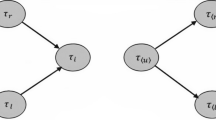Abstract
The current chapter is devoted to roughification. In the most general setting, we intend the term roughification to refer to methods/techniques of constructing equivalence/similarity relations adequate for Pawlak-like approximations. Such techniques are fundamental in rough set theory. We propose and investigate novel roughification techniques. We show that using the proposed techniques one can often discern objects indiscernible by original similarity relations, what results in improving approximations. We also discuss applications of the proposed techniques in granulating relational databases and concept learning. The last application is particularly interesting, as it shows an approach to concept learning which is more general than approaches based solely on information and decision systems.
Access this chapter
Tax calculation will be finalised at checkout
Purchases are for personal use only
Preview
Unable to display preview. Download preview PDF.
Similar content being viewed by others
References
Abiteboul, S., Hull, R., Vianu, V.: Foundations of Databases. Addison-Wesley (1996)
Baader, F., Calvanese, D., McGuinness, D.L., Nardi, D., Patel-Schneider, P.F. (eds.): Description Logic Handbook. Cambridge University Press (2002)
Baader, F., Nutt, W.: Basic description logics. In: Baader et al. [2], pp. 47–100
Borgida, A., Lenzerini, M., Rosati, R.: Description logics for databases. In: Baader et al. [2], pp. 472–494
Divroodi, A., Nguyen, L.: On bisimulations for description logics. CoRR abs/1104.1964 (2011) (appeared also in the proceedings of CS&P 2011, pp. 99–110)
Doherty, P., Łukaszewicz, W., Skowron, A., Szałas, A.: Knowledge representation techniques. A rough set approach. STUDFUZZ, vol. 202, Springer (2006)
Doherty, P., Łukaszewicz, W., Szałas, A.: Computing strongest necessary and weakest sufficient conditions of first-order formulas. In: International Joint Conference on AI, IJCAI 2001, pp. 145–151 (2000)
Doherty, P., Łukaszewicz, W., Szałas, A.: Tolerance spaces and approximative representational structures. In: Proceedings of 26th German Conference on Artificial Intelligence. Springer (2003)
Doherty, P., Szałas, A.: On the Correspondence between Approximations and Similarity. In: Tsumoto, S., Słowiński, R., Komorowski, J., Grzymała-Busse, J.W. (eds.) RSCTC 2004. LNCS (LNAI), vol. 3066, pp. 143–152. Springer, Heidelberg (2004)
Doherty, P., Szałas, A.: A correspondence framework between three-valued logics and similarity-based approximate reasoning. Fundamenta Informaticae 75(1-4) (2007)
Fanizzi, N., d’Amato, C., Esposito, F., Lukasiewicz, T.: Representing uncertain concepts in rough description logics via contextual indiscernibility relations. In: Proceedings of URSW 2008. CEUR Workshop Proceedings, vol. 423 (2008)
Greco, S., Matarazzo, B., Słowiński, R.: Fuzzy Similarity Relation as a Basis for Rough Approximations. In: Polkowski, L., Skowron, A. (eds.) RSCTC 1998. LNCS (LNAI), vol. 1424, pp. 283–289. Springer, Heidelberg (1998)
Hopcroft, J.: An n logn algorithm for minimizing states in a finite automaton (1971), ftp://reports.stanford.edu/pub/cstr/reports/cs/tr/71/190/CS-TR-71-190.pdf
Lin, F.: On strongest necessary and weakest sufficient conditions. In: Cohn, A., Giunchiglia, F., Selman, B. (eds.) Proc. 7th International Conf. on Principles of Knowledge Representation and Reasoning, KR 2000, pp. 167–175. Morgan Kaufmann Pub., Inc. (2000)
Lin, T.: Granular computing on binary relations I, II. In: Polkowski, L., Skowron, A. (eds.) Rough Sets in Knowledge Discovery 1: Methodology and Applications. STUDFUZZ, vol. 17, pp. 107–140. Physica-Verlag (1998)
Nardi, D., Brachman, R.J.: An introduction to description logics. In: Baader et al. [2], pp. 5–44
Nguyen, H., Skowron, A., Stepaniuk, J.: Granular computing: A rough set approach. Computational Intelligence 17, 514–544 (2001)
Nguyen, L.: An efficient tableau prover using global caching for the description logic \(\mathcal{ALC}\). Fundamenta Informaticae 93(1-3), 273–288 (2009)
Pawlak, Z.: Rough Sets. Theoretical Aspects of Reasoning about. Data. Kluwer Academic Publishers, Dordrecht (1991)
Pawlak, Z., Skowron, A.: Rough sets and Boolean reasoning. Inf. Sci. 177(1), 41–73 (2007)
Pawlak, Z., Skowron, A.: Rudiments of rough sets. Inf. Sci. 177(1), 3–27 (2007)
Peters, J., Ramanna, S., Skowron, A., Stepaniuk, J., Suraj, Z., Borkowski, M.: Sensor fusion: A rough granular approach. In: Proc. of the Joint 9th International Fuzzy Systems Association World Congress and 20th NAFIPS International Conference, pp. 1367–1371 (2001)
Polkowski, L., Skowron, A.: Towards adaptive calculus of granules. In: Zadeh, L., Kacprzyk, J. (eds.) Computing with Words in Information/Intelligent Systems, vol. 1-2, pp. 201–227. Physica-Verlag (1999)
Skowron, A., Stepaniuk, J.: Tolerance approximation spaces. Fundamenta Informaticae 27, 245–253 (1996)
Skowron, A., Stepaniuk, J.: Information granules: Towards foundations of granular computing. International Journal of Intelligent Systems 16/1, 57–86 (2001)
Skowron, A., Stepaniuk, J.: Information granules and rough-neurocomputing. In: Pal, S.K., Polkowski, L., Skowron, A. (eds.) Rough-Neuro Computing: Techniques for Computing with Words, pp. 43–84. Springer (2004)
Ślęzak, D.: Rough sets and few-objects-many-attributes problem: The case study of analysis of gene expression data sets. In: FBIT, pp. 437–442. IEEE Computer Society (2007)
Ślęzak, D., Wróblewski, J.: Roughfication of Numeric Decision Tables: The Case Study of Gene Expression Data. In: Yao, J., Lingras, P., Wu, W.-Z., Szczuka, M.S., Cercone, N.J., Ślęzak, D. (eds.) RSKT 2007. LNCS (LNAI), vol. 4481, pp. 316–323. Springer, Heidelberg (2007)
Słowiński, R., Vanderpooten, D.: Similarity relation as a basis for rough approximations. In: Wang, P. (ed.) Advances in Machine Intelligence & Soft Computing, pp. 17–33. Bookwrights, Raleigh (1997)
Słowiński, R., Vanderpooten, D.: A generalized definition of rough approximations based on similarity. IEEE Trans. on Data and Knowledge Engineering 12(2), 331–336 (2000)
Szałas, A.: Second-order reasoning in description logics. Journal of Applied Non-Classical Logics 16(3-4), 517–530 (2006)
Author information
Authors and Affiliations
Corresponding author
Editor information
Editors and Affiliations
Rights and permissions
Copyright information
© 2013 Springer-Verlag Berlin Heidelberg
About this chapter
Cite this chapter
Nguyen, L.A., Szałas, A. (2013). Logic-Based Roughification. In: Skowron, A., Suraj, Z. (eds) Rough Sets and Intelligent Systems - Professor Zdzisław Pawlak in Memoriam. Intelligent Systems Reference Library, vol 42. Springer, Berlin, Heidelberg. https://doi.org/10.1007/978-3-642-30344-9_19
Download citation
DOI: https://doi.org/10.1007/978-3-642-30344-9_19
Publisher Name: Springer, Berlin, Heidelberg
Print ISBN: 978-3-642-30343-2
Online ISBN: 978-3-642-30344-9
eBook Packages: EngineeringEngineering (R0)




